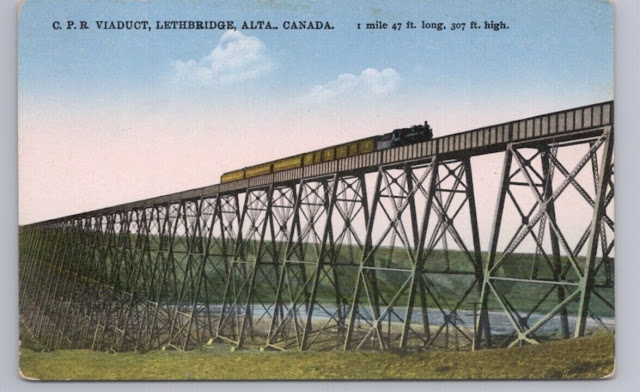(
Satellite,
Steve Boyko blog)
 |
Bob Kline posted
Lethbridge, Alberta, circa 1908. "Erecting Lethbridge Viaduct over the Oldman River." 8x10 inch glass negative. So that's how they did it.....
Richard Koenig Never saw this before: a big template is used, begin at bottom and work up.
Jeff Bransky The big rectangular framework at the top is like a template or armature but it is also scaffolding for workers to stand on. Very impressive. I like seeing the men standing at ground level and on the concrete pads for a feeling of scale. It is also interesting to see the large moveable crane reaching way out to build the vertical support structure that is nearing completion.
Bridges Now and Then posted
"Lethbridge Viaduct construction. Engineers and workers at the Lethbridge Viaduct during its construction. This railroad bridge was built from summer 1907 to August 1909 over the Oldman River at Lethbridge, Alberta, Canada. It was built by the Canadian Pacific Railway. The onsite engineer was John Edward Schwitzer. A crew of 100 erected 33 steel girder towers from mid-August 1908. This was aided by a travelling crane (upper centre) on the railroad that lowered the girders into position. The viaduct's height above the river is 96 metres, and the length is 1624 metres. Photograph from the Detroit Publishing Company." (Library of Congress)
Garry Davis: See how the engine has pulled back well clear of any potential structural failure during erection of the leg truss units |
 |
Bridges Now and Then posted
"View showing the one stage of construction on High Level Bridge, Lethbridge, Alberta. The traveller is visible. Area of the river valley also visible." (Galt Museum & Archives) |
A detail of some of the towers.
 |
Kathy Koenig posted
The High Level Bridge in Lethbridge, AB. is the longest, highest bridge of it's kind in the world. It is 1.6 km long and is 96 meters high. It was completed in 1909 and is still used by the Canadian Pacific Railway numerous times a day.
[There are many photos in the comments.]
Ken Heitzenrater shared
These viaducts make me think of the term "cookie cutter" as used in referring to houses built in a housing project.
These viaducts of the early 1900's have the same look which leads me to ask - were they individually designed or was there a "stock" of pre fabricated parts to draw from to build one.... |
The curved black line you see in the overall satellite image referenced above is a shadow of the deck. If you zoom in, you can see the deck, piers, and trestle steel. On the south side the trestle steel is clearly visible because it does not have the confusion caused by the shadows.
 |
Jeff Bransky commented on the above posting
This photo reveals the finished viaduct where you can see the spacing of the framework modules easier. In addition, the B&W construction photo shows temporary bracing on the sides of the end structure which was later removed. If you look below the smaller steam crane in the construction shot, you can see men on scaffolds working. They may be painting the bridge. I'm assuming the rivets were previously installed in the area where they are working. To see more photos visit this site which also shows the river in flood stage:
http://dailyphotodose.com/tag/high-level-bridge/
[Note the man standing on the front pier in the first photo. The flood pictures show the water almost covering those piers. So the river level is up about 15-20 feet.] |
Savoie Photography
posted three photos with the comment: "
Grabbed a few more shots of the Holiday Train Leaving over the High Level Bridge tonight. Thanks again CP Rail for bringing this unique train by for us to enjoy !"
Joe Dockrill
shared
 |
| 1 |
 |
| 2 |
 |
| 3 |
 |
| Jeff Bransky commented on the above posting |
 |
| Jeff Bransky commented on the above posting |
 |
Photo by J.Chong from a blog posting on Canadian rail scenes
In Lethbridge, 150 km. south of Calgary, there is still an active rail line on top of the world’s highest freestanding iron black trestle bridge. The rail bridge straddles the natural dips of prairie grassy coulees. This iron trestle bridge is a tourist attraction since such structures are rare in Canada, even in North America. We wandered into the grassy parkland, in the dying summer heat of 30 degrees C at sunset. Quite stunning. |
 |
Western Canadian History posted
1908 ~ CPR's Lethbridge Viaduct while under construction showing the "traveller", a custom built crane on wheels, in position for the next section to soon be erected.
Finished in August of 1909 and at just over a mile in length, this is the world's largest steel structure of its kind. It may appear frail, but this bridge was purposely over-engineered and is still in constant use today.
https://en.wikipedia.org/wiki/Lethbridge_Viaduct
And takes a while to re-tie.
Took 4 years last time... the only work in the summer...
Was the river temporarily dammed? Very low flow.
Those footings you see in the photo were placed when the river was low by building caissons or by a simple diversion, first to one side, then the other.
The first attempt was "derailed" by spring flooding
|
Robert D Austin Jr
posted two photos with the comment: "Still in use--longest trestle in western Canada. Lethbridge High Bridge! Built in 1912."
 |
| 1 |
 |
| 2 |



















 (sorry no train going across when I was there)
(sorry no train going across when I was there)






















No comments:
Post a Comment